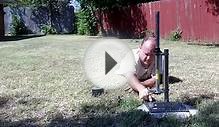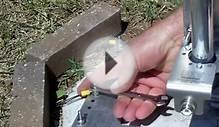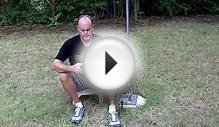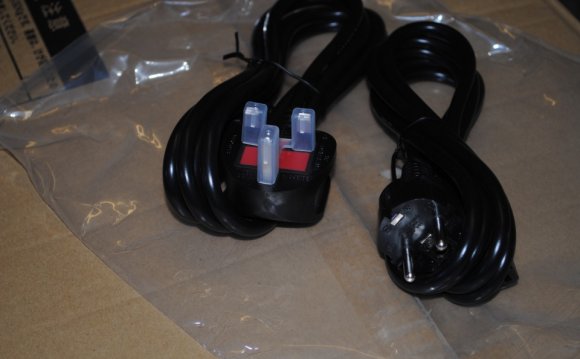
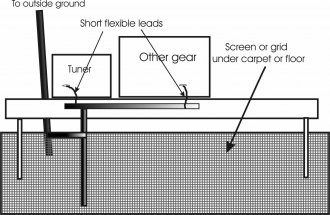 Because the radiating area is often brought into or near the operating position, longwires often create RF interference to consumer goods or RF in the operating room. The easy installation part comes from generally needing only two supports, and not having a heavy feedline hanging from mid-span like a dipole. The long expensive feed cable normally associated with a doublet or dipole is not needed, the antenna wire itself serving as a "feedline".
Because the radiating area is often brought into or near the operating position, longwires often create RF interference to consumer goods or RF in the operating room. The easy installation part comes from generally needing only two supports, and not having a heavy feedline hanging from mid-span like a dipole. The long expensive feed cable normally associated with a doublet or dipole is not needed, the antenna wire itself serving as a "feedline".
The antenna itself works just as well as any other wire of similar height and length. Any or all problems are in the counterpoise and feed system. The difficult problems associated with random wire or longwire antennas are caused by ground currents and radiation from the single wire feeder.
End-fed antennas, or antennas with the single wire feeder brought into the shack, come with a little misconception. One commonly repeated myth or "theory" is that half-wave antennas, being resonant, do not require a counterpoise, or that some magical length of antenna will prevent RF in the shack. This does not mean the antenna will be worthless and not make contacts, it simply means something else replaces the missing counterpoise area and we also bring RF fields right into the shack. The feedline, as well as everything connected to and surrounding the single-wire feedline and counterpoise, becomes part of the radiating system. This creates three potential problems:
1.) The feedline, mast, and things around the feedline connect through the antenna into the receiver. This brings noise into the receiver.
2.) The feedline, mast, and things around the feedline become part of the radiator. This brings voltage (electric fields) and current (magnetic fields) directly into the shack.
3.) The feedline and grounding affects SWR and tuning.
Since we often do not have a baseline for noise, unnecessary additional noise will often go unnoticed. The remaining two issues are more likely to be noticed, but only if we run enough power to cause RF burns, power supply shutdown, or other forms of RFI.
Transmitter power levels, feedline length and routing, and the susceptibility of equipment to RF problems greatly influence things we most likely notice. This is why some people (usually with QRP power levels) swear by end-fed half-waves, while others (usually with higher power) avoid end-fed antennas. The reason for that is simple, end-fed half waves have common mode feedline current problems affecting their performance, and these common mode currents cause inconsistency in user satisfaction.
In nearly all cases, if we notice it or not, an inadequate counterpoise hurts antenna pattern and efficiency. This is why high power stations often have more efficient, more ideal, antenna systems. Higher power very often excludes use of power wasting systems, because the wasted power often creates significant local problems. If 5% of 10 watts is exciting the desk with RF, it isn't any big deal. If 5% of 1500 watts excites the desk with RF, the result can be hazardous.
I wouldn't have a problem with a 1500 watt transmitter into a longwire antenna with a tuner remote from the shack and house. I would likely have a fire, or damage equipment, if I brought a single-wire feeder into the house! With 5 or 10 watts, I wouldn't care.
How the Longwire or Random Wire Antenna Works
The single wire feeder not only radiates electromagnetic energy, it has very strong electric and magnetic induction or energy storage fields surrounding the wire for some distance out from the wire.
In order to force current up into the feed wire and antenna, the matching or feed system has to "push against" something else. For every milliampere of current flowing into the feed wire of the longwire antenna, an exactly equal current has to flow into a ground system of some type! In any non-terminated antenna, currents and voltages are transformed along the antenna. This transformation is caused by standing waves. This means ground lead currents can increase or decrease along the ground wire and everything connected to the ground wire or ground system. Voltage changes also along the ground or counterpoise system, just as it does in antennas. The voltage caused by antenna return currents, and the return current, will become stronger (more intense) or weaker (less intense) because of standing waves on wiring and equipment cases.
These ground currents, displacement currents, or common mode currents cause everything connected to the matching system to become "hot" with RF. The result is generally all sorts of RF interference to active devices or even physical harm to the operator, such as actual burns or on lower bands like 160-meters. electrical shocks! These unwanted but very necessary currents ideally should flow through the lowest impedance path and widest area path we can manage.
Noise from Longwire Antennas
Radiation and fields surrounding the single wire feed system not only leak out, unwanted noise and signals can also leak in. Radiation from the feeder and everything connected to the matching system, as well as common mode currents, also allows . This deteriorates receiving system noise performance.
Common mode currents and induction field coupling also decreases transmitting efficiency. This effect adds unnecessary loss to the system.
If things are just right (like having a fairly good RF ground in the shack) and power is fairly low, we can often "get away" with having a random wire or longwire brought directly into the shack, but that is more a matter of good fortune than good planning.
Repeating and expanding on what was said above, radiation and fields surrounding the single wire feed system not only leak out, unwanted noise and signals can also leak in. This is an unsolvable problem with a single wire feed. The very best we can do is relocate these problems to an area where they cause no noticeable problems. We can do this by relocating the feedpoint. Relocating the feedpoint can move strong magnetic and electric fields away from the operating position, house wring, consumer devices, and our sensitive equipment. This reduces noise into the antenna feed system, and RFI caused by the antenna feed system.
how many solution calculator how device is rooted how much project engineer make why products are so cheap on meesho where to launch kayak on windermere how smart solutions what entrepreneur really means how often processing solution should be replenished who technology transfer hub why startup india project where design how far answer how entrepreneur contribute to economic development how management fee is calculated from where were new workers recruited where to produce music where's the london bridge in arizona where to go from business analyst where to buy engineering paper where does engineers work which solutions conduct electricity how many solutions does this have where to launch rockets near me how often should a manager give feedback why system maintenance is important where is the source located who tech transfer to whom project manager reports why startup fail who is engineering explained when entrepreneurs develop new products how startup stock options work when engineering day is celebrated who designs buildings and houses how much project manager earn in uk why equipment is important when tech companies lie to us when tech companies lie to us where to manage amazon credit card who project kenyatta university how far science has come what is a development milestones how design awards why technology is good how much project coordinators make how much startup capital for small business how product management works with ux who set up netflix what machines or equipment can you operate how far technology has advanced why startup india failed when design and access statement required how many tech jobs in the us who buy products and who use product who roadmap ventilation to whom project manager reports where is sewerage system from how science works book how many project sekai characters are there where's video manager on youtube how entrepreneur think how much equipment does have why london is a good place to live who set up whatsapp how much company stock in 401k how often can you use stim who workers comp who business continuity plan which science is the easiest how many entrepreneurs how london bridge fell who technology transfer pdf what's the roadmap for lifting lockdown whose project is mrt 7 where is liverpool manager from who technology addiction what startup services can i disable when was startup filmed which manufacturer has the absolute advantage where was technology first invented teachers day how much startup costs can i deduct where is number system from where device link is used where to download solution manuals for free whose forest solution how many teaching positions are open in nc how many entrepreneurs become millionaires where to design stickers how often growth spurts who manager definition when company goes public how often does waste management bill how to do roadmap how far london to ireland how many development cards in catan expansion care where solutions how manufacture a product how to meet startup founders when startup stops being startup how long does technology last when management doesn't listen how business credit works how company 401k match works when tech bubble burst how manager handle conflict who technology in healthcare where to buy technology where to solve python problems how much tech deck does development mean progress how start up a business how often is continuously where's tech n9ne from whose business is safeguarding how much tech deck how much entrepreneurs work what solution is used for sclerotherapyINTERESTING VIDEO
